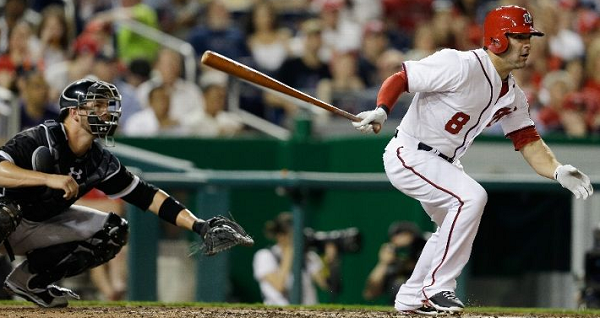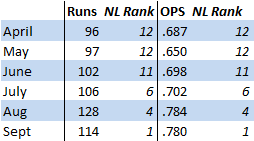A song for you to listen to while reading this post…
It’s over
You don’t need to tell me…
I got no distance left to run
I’m sure Damon Albarn had something besides the Nats in mind when he wrote those words (no, really, I’m positive), and yeah, I’ve skipped some of the content from the song (probably important to getting the full gist), but the sentiment remains. It’s over for the Nats, it’s been over for a while, despite some unrealistic excitement over the last few weeks, and many of you, like me, are exhausted.
I’m not exhausted because of August, or even of September, really. I’m still beat from watching this team in April and May. They were so much worse than they could have been, they lost so many games in painful fashion, and yet they still hung on.
The team improved dramatically over the course of the season, basically by hitting as well as could be expected, if not better than could be expected. But it was too little, too late. This won’t be a surprise to anyone who’s followed the team, but here’s how they did in a couple of basic but important offensive categories, month by month, up to this point:
That pretty much sums it up, right? There’s plenty more detail as to why they were so bad, and I don’t want to totally dismiss pitching, but that’s it. It boils down to this:
[highlight style=’magenta’] The Nats had a poor offense in the first half, due to injuries coupled with a very poor bench, as well as a bad Danny Espinosa, resulting in a poor record, and they didn’t recover in time to make the playoffs. [/highlight]
That’s really it. That’s why it was so bad early on. The return of key players was why they suddenly get better.
Yes, Dan Haren‘s ERA+ of 77 was miserable and certainly contributed negatively to the season. And I wrote about the decline of Rafael Soriano already, especially his fastball, although I believe that his contributions can be overstated a bit. He has 6 blown saves, but they only lost 3 of them by my count (he has a few late inning losses when they were tied as well). Still, he has regressed enough to maybe not be guaranteed the closer role next year. But none of the pitching issues contributed the way the poor hitting did.
[button url=’#’ size=’small’ style=’blue’] The Bad Offense [/button]
Espinosa was a terrible player this year, and they stuck with him for so long. I certainly was a fan of the guy, and I was with him for a while. But even I, the Espinosa-shirsey-owning fan that I am, knew he was broken by mid-May. But I’m not the GM of the team, I’m just a guy who writes about the Nats and walks around the entirety of Nats Park to make a beer map. This should have been fixed earlier, and I am in disbelief that Espi still has not gotten surgery on his shoulder.
Meanwhile, the bench was atrocious. I’ve written about it time and time again, but let me just show you one of my favorite (well, least favorite) charts on the season that shows how bad their backup outfielders were, and how much they were used. These guys are shown only with their numbers as outfielders or pinch hitters:
I wrote about this when they finally brought up Corey Brown, but he probably wasn’t a cure-all for their woes. Although I do strongly believe he would have improved their .520 OPS. And they did recognize this issue eventually and brought in Scott Hairston, who was an improvement, but by then the injured players had gotten better and the bench players went back to being on the bench. But the fixes came way too late.
And that touches on the biggest issue, certainly the biggest non-Espinosa issue – the bench players had to play way too much, and when they did, they weren’t good. There should be little surprise that the offense started to improve in June (certainly the OPS, and the runs were tracking in the right direction) and really hit their stride in July.
I said it back on July 2, that this team was going to be much better soon. It wasn’t hope or fanhood, it was simple logic, and I was paying attention. They had been playing bench players, who were stinking up the joint, and people were coming back.
I am not sure that many Nats fans were clamoring for a better bench, considering how well Tyler Moore, Steve Lombardozzi and Kurt Suzuki did in 2012. But I did see it from some sportswriters (I, much like Rizzo, didn’t think it was something that really needed to be addressed), and the advanced metrics and predictors like PECOTA didn’t look warmly upon those players.
You can fault the GM for both issues, and I do, although I don’t think either situation was totally predictable, despite the projections. I won’t get into the reasons why Espi seemed like a starting second baseman, but lots of people thought that, not just Rizzo, Neyer and I. And the bench was incredible last year. Sure, there was some regression expected, just not so much.
In fact, Lombardozzi has recovered quite nicely from earlier in the season. You know, when he was really needed. Before the All Star break, he hit .234/.246/.293. That aint a major leaguer. After, he hit .309/.343/.436. That’s an All Star second baseman.
But that’s the nature of being a Major League bench player. They go a year with an .850 OPS, another with a .650. If they were consistently good, they’d start. If they were consistently bad, they’d be in AAA. If you ever needed proof of how small sample sizes can skew things, bench players like Lombo are it.
There were other issues for sure – Adam LaRoche had an extremely disappointing season. His OPS will end up ranking just in the middle among NL 1Bs, but it’s thanks to a middle of the road OBP and SLG. In other words, he wasn’t good in either, he was just good enough in both to not be awful. Denard Span was really bad early on, although a late season recovery has allowed him to rank a little higher in the OBP and OPS categories among NL center fielders.
[button url=’#’ size=’small’ style=’blue’] Triple Trouble [/button]
In other words, those two guys weren’t good, they were actually kind of bad, but they just weren’t the kind of drag that the .520 OPS/433 PA monster outfielder was. Like, not even close to how bad he was. He hit worse than the awful .593 OPS of Kurt Suzuki, but not as bad as Espi’s .465 OPS.
Those “three” did it (Espi, Kurt, and Frankenoutfield), and by the time the Nats were able to replace them, through guys coming off the DL, it was really too late.
In July, the Nats went on a 10 game stretch where they went 2-8. You remember that, it’s probably the first time people said the season was over. I certainly said it. It was, in essence, the beginning of the end. They played so well afterwards that they looked like they could do something, and they’ll finish with enough wins to say “some years, that would’ve been enough to make it.” But not this year.
The problem with blaming that stretch is that they could have easily sustained the kind of run if they had actually played well at all in April and May. The Cardinals had a 2-8 run this year, and a separate 3-7 run. The Reds had two 3-7 stretches, so did the Pirates. No, that 2-8 stretch wasn’t what killed the season, it was their first half. The 2-8 stretch just meant that they weren’t going to go undefeated in the second half, not that they were a bad team.
[button url=’#’ size=’small’ style=’blue’] Lessons Learned [/button]
The good news, though, is that all this leads me to the same conclusion I came to at the end of July – it doesn’t make sense to make a ton of changes to this offense. Back then, it might not have been so obvious, but now it’s clear they CAN score. And now we know why they didn’t do it early on. So what’s a GM to do?
There are decisions to be made, certainly about Adam LaRoche and Denard Span (although I don’t think anything should be done about the latter), but there is one thing that Rizzo do with this starting lineup to fix the team… concentrate elsewhere.
It’s the bench that needs the attention. He has to anticipate that his catcher will get hurt, and one of his outfielders as well. When that happens, he needs guys off the bench who can perform at an above-.520 OPS level, unlike this year. If he does that next year, heck, if he did that this year, you’re looking at a playoff team.



